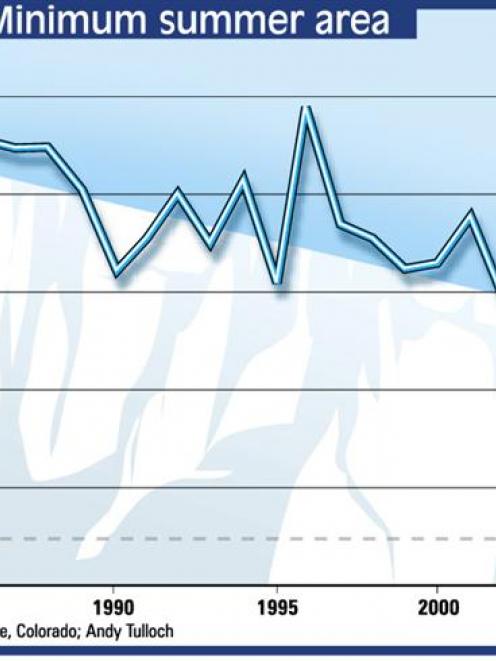
Recent correspondence to the ODT provides an example of how environmental statistics can be misunderstood, and possibly used to support an unlikely conclusion with regard to global warming.
I can't claim to be an expert on either sea ice or statistics, but in this case I think a classic error has been made because only a small part of the relevant information has been considered.
Such mistakes are unfortunate because they add unnecessary confusion to a vitally important issue.
A report in the ODT (19/09/09) on this year's northern-summer minimum area of Arctic Ocean sea ice noted that the ice area had continued its overall decline.
Jock Allison (3/10/09) took issue with this conclusion, suggesting that the new data did not support a trend of reducing summer sea ice.
He quoted the 1979-2000 average summer sea ice extent as 6.7 million sq km, 4.1 million sq km in 2007, 4.7 million in 2008 and 5.1 million in 2009, noting that the minimum area of sea ice has increased more than 20% from the 2007 level.
However, news reports are often unfortunately brief.
To get the full picture, especially if in doubt, the original source should be sought; in this case that is the National Snow and Ice Data Centre in the United States.
This US Government source collates regular satellite-based microwave radiometer measurements of the area of the Arctic Ocean covered in ice.
This data, accompanied by explanatory information, is freely available in varying levels of detail, on their website.
The accompanying graph, based on data from that source, shows the full set of summary data from the entire period over which measurements have been taken (1979-2009) and displays a reasonably compelling trend of declining summer sea ice, as originally reported.
The long-term rate of decline is about 11% per decade, suggesting that the Arctic Ocean may be largely ice free in summer by the middle of this century, possibly much sooner.
In the context of the long-term trend, there is nothing contradictory in the 2007-09 data.
To suggest that these three most recent measurements contradict this trend is unreasonable.
It's a bit like saying that summer won't be coming this year because a few days in August were warmer than the equivalent days in September.
The ups and downs about this trend are likely to be due to complex interplay with numerous natural processes, but the overall declining pattern is strong.
This melting trend is reinforced by measurements that also show decreasing ice thickness, especially of new annual winter ice.
That makes it more vulnerable to re-melting than the tougher long-term perennial ice, of which more than half has already melted.
The correspondent also makes two other statements that appear to downplay the underlying issue of global warming.
Firstly, he mentions that Arctic sea ice accounts for only 0.01% of the world's ice.
That may be so, but that does not mean it is not very important.
Because this small amount of ice is spread thinly it can melt relatively easily.
This is important because even a modest amount of melting can rapidly change a significant fraction of the Arctic Ocean from white ice to dark ocean.
Ice reflects about 80% of sunlight, and its heat, back into space, slowing global warming, but dark ocean absorbs about 90% of the heat from sunlight.
So, even this small volume of ice is playing a very important role in reducing global warming.
Conversely, removal of the summer ice has the potential to accelerate global warming significantly.
Secondly, he states that the world has been cooling since 2002.
That's a very significant statement that demands more than a one-liner.
- Andy Tulloch is a geologist with GNS Science. This article is his personal viewpoint.











